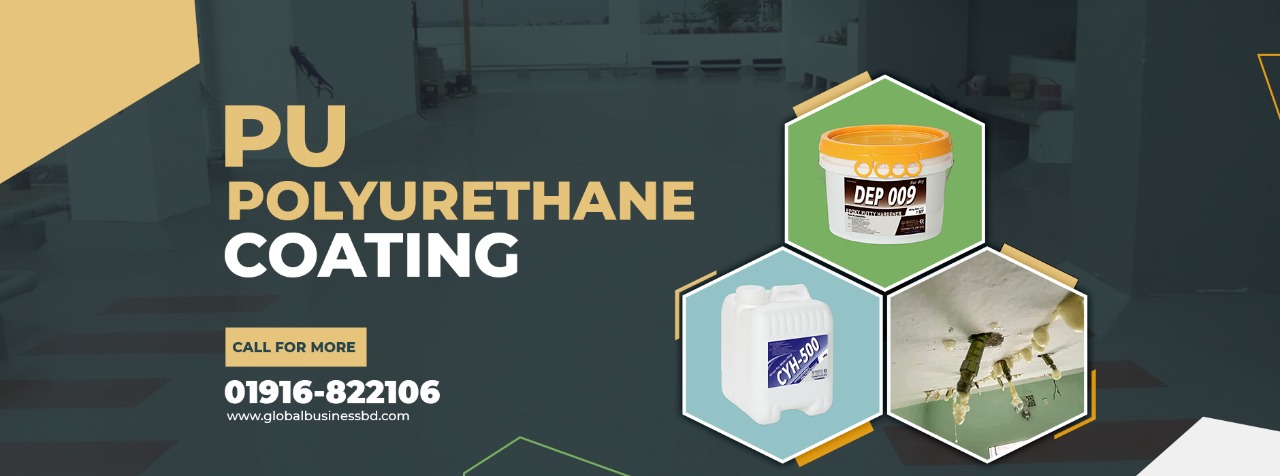

What is PU Injection
PU injection, also polyurethane grouting or injection, is a waterproofing technique that uses expanding injected polyurethane to prevent water flowing through and voids or cracks typically in concrete. This is effective in solving water leakage issues, especially when applied on the underside of the seepage area or the lower floor ceiling where the leak occurs.
Process
A hole will first have to be drilled on the underside of the ceiling, allowing polyurethane foam to be injected using a pressure machine. The pressure causes the polyurethane to ascend into any crack or voids caused by water damage, which will be filled up when it expands. PU injection is a recommended method to be applied to actively-leaking cases involving concrete slabs.
Properties of PU (Polyurethane)
Polyurethane is a fluid resin that can be injected into cracks, fissures and other voids in concrete building structures. When injected into concrete during a leak repair, within minutes the polyurethane undergoes a chemical transformation from a liquid to a solid. The suitability of polyurethane as a waterproofing method stems from its inherent properties. It has a very short curing time. Which makes it a highly ideal material for sealing active leaks. It has low viscosity allowing it to comfortably seal tiny cracks after curing on moisture. Following an injection, polyurethane will cure and retain its flexibility, which allows for subsequent movement in the structure while keeping the voids sealed, hence preventing the leak from occurring.
Advantages of Polyurethane for Waterproofing
If you are considering using PU injection method for your leak repair, it is useful to know that it holds some advantages over other waterproofing methods. Polyurethane is a versatile polymer that has industrial applications for coating and insulation purposes. It is a strong adhesive and waterproofing material. As it is flexible and tough, polyurethane will protect well against membrane cracks and building movements that could compromise waterproofing effectiveness. The fact that it is highly elastic provides it resistance to thermal expansion as well as deterioration due to exposure to sunlight. This makes it one of the most suitable methods for application on surfaces such as roof and balconies. It is also popularly used to repair active leaks due to its fast drying property and ability to seal tiny hairline cracks and are otherwise hard to spot. Compared to other methods which involve heavy hacking, it is a relatively clean and a low cost solution. In addition it requires little to almost no further maintenance.
PU Injection To Repair Cracks
PU injection undergoes an expansion process with water, any cracks that are filled in will have a blend of water and the polymer foam type PU grout. The mixture will then expand until there is no more space to fill, successfully sealing off any pathways the water enter through the material.
Residential Properties
PU injections are a cost efficient method to repair leaks coming into your house, especially water coming in from the exterior. PU can also be injected in to the roof to prevent further roof leak and damage to property and articles.
Industrial Properties
PU injection are also commonly used to repair factory or warehouse flooring, which can be damaged after prolonged and repetitive use of heavy machinery such as forklifts. PU grouting can also be applied in many areas where there is visible leak. It is commonly used in areas such as drainage, piping and ceilings. Similar as its residential applications, you can use it to repair any damage in your properties caused by rain or leaking.
Typical Causes of Building Cracks
Bad Drainage
Dampness is the main cause of building cracks. Poor drainage can cause water seepages that creates holes and wears away concrete and other building materials over time. Almost all properties are susceptible to damage from water, humidity and dampness. The leaks and cracks that they might cause can be successfully treated with PU injection.
Heavy Load
Heavy loads due to movement of machinery and vehicles such as forklift trucks and lorries on a regular basis will cause cracks on the floor over a prolonged period of time. Usually, cracks might be severe especially in areas of high traffic volume. As many warehouses with tin roof can leak over time, water on the ground will cause holes and gaps through the cracks, which can be repaired with PU by filling them up.
Wear and Tear
Water remains the most common cause of cracks in buildings. As buildings age, cracks may appear due to wear and tear especially if there is inadequate level of maintenance. This is especially important in areas such as roofs, balconies and the wet areas exposed to water. Filling up these cracks with PU can help to prevent leaks without major renovation.
PU Waterproofing Leakage Repair
Cracks in concrete structures can happen to wider environmental factors such as thermal movement, soil movement due to nearby construction works and others. While it is not yet severe, minor cracks will not cause any visible leak or any damage. However, cracks will increase over time usually due to water penetration, resulting in leaks and damage to property. We provide a comprehensive PU injection and grouting services to assess and carry out necessary repairs using modern methods. As soon as you observe any visible leak, it would be wise to take action to protect your property against further water damage. PU waterproofing can be applied in many areas of the building: • Wet areas including toilets, showers and kitchens • Concrete, tile, or metal roofs • Balconies and patios • Basements, foundations and retaining walls • Water tanks
Copyright Ⓒ 2022 Global Business Solution All Rights Reserved.